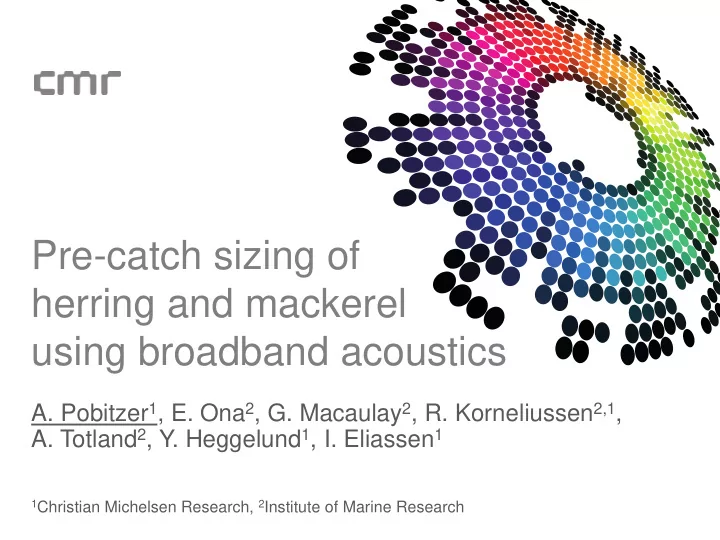

Pre-catch sizing of herring and mackerel using broadband acoustics A. Pobitzer 1 , E. Ona 2 , G. Macaulay 2 , R. Korneliussen 2,1 , A. Totland 2 , Y. Heggelund 1 , I. Eliassen 1 1 Christian Michelsen Research, 2 Institute of Marine Research
Motivation for pre-catch sizing Purse seining • Traditional catch method for schooling fish • Workflow 1. Circumnavigate school setting the net 2. Purse the seine 3. Pull up net 2
Motivation for pre-catch sizing • Sizing : price ~ length / weight of fish price ~ size distribution • Pre-catch: prevent «slipping» prevent time-consuming sampling • reduce fish mortality • comply with regulations • Challenge: resolve and measure individual fish • sideways • at 50 – 100 m range 3
Outline of proposed method 1. Resolve single targets in outskirts of schools with split beam wide band principle and a very narrow beam 2. Find size related parameters in TS, pulse form and backscattered spectrum 3. Compute statistical parameters 4. Visualize estimated size in echogram 4
Example: Resolve single targets in outskirts of schools (sideways) Narrow-beam (3 o ) broadband SB-transducer (160 – 260 kHz), mounted on keel of “G.O. Sars ” (LSSS, forthcoming release) Mackerel school at 20 – 120 m (sideways) data acquired during cruise in autumn 2014, “G .O. Sars ” 5
Size estimation based on TS spread • Observations • spread in the TS spectrum ~ constant under rotation • larger fish ~ more spread • 3 rd quartile – median stable quantifier of spread • Empirical model for 𝑀(𝑡𝑞𝑠𝑓𝑏𝑒) 6
Size estimation based on echo duration • (Stanton et al., 2003) : 2⋅𝑀 𝑓𝑔𝑔 Δ𝜐 = |cos(𝜚)| 𝑑 ( 𝜚 unknown) • Here: 𝑀 𝑓𝑔𝑔 unknown • Use least-square curve fit 𝑀 𝑛𝑓𝑏𝑡𝑣𝑠𝑓𝑒 = 0.34 𝑛 for estimation of 𝑀 𝑓𝑔𝑔 (𝑀 𝑓𝑔𝑔 ≈ 𝑀 ⋅ 0.9 = 0.306 𝑛) • Problematic areas • 𝜚 ≈ 0 ∘ (acquisition) • 𝜚 ≈ 90 ∘ + 𝑙 ⋅ 180 ∘ , 𝑙 ∈ ℤ (model) 7
Size estimation based on dips in frequency spectrum • Observation: number of dips in spectra follows 𝑜𝑒𝑗𝑞𝑡(𝜚) = 𝑏|cos(𝜚)| • Less unstable for 𝜚 ≈ 0 ∘ • Least square fit for estimation of 𝑏 = 𝑜𝑒𝑗𝑞𝑡(0 ∘ ) • Empirical model for 𝑀(𝑏) • TS spectra for 𝜚 ≈ 90 ∘ + 𝑙 ⋅ 180 ∘ , 𝑙 ∈ ℤ «flat» model applicable 8
Robustification of size estimation • Minimise influence of noise by combining all three measurements taking median • 𝜚 ≈ 0 ∘ problematic for size estimation based on signal length (and to some extent number of dips) use the TS spread only 9
Software implementation • Methodology implemented in prototype • EK80 data Track single fish extract features needed for three methods present size probability to user • Features • Real-time • For now herring and mackerel 10
Detail: Computation of probability • Probability estimation through K ernel D ensity E stimation • KDE ≈ continuous histogram • Advantage: takes uncertainty in account! • Measured size μ + uncertainty σ 𝑂(μ, σ) • Superposition gives estimation of probability density function of population 11
Video from software (mackerel) 12
Summary & future work • DONE • Proposed pre-catch sizing algorithm based on • TS • pulse form • spectral information • Currently limited to herring and mackerel • Prototype implemented and tested in field • TO DO • Extension to other species? • Influence of dorsal incidence angle, depth (swimbladder compression)? • … 13
Acknowledgments • The here presented work is a result of the DABGRAF-project, founded by The Norwegian Seafood Research Fund – FHF • Simrad for the use of EK80 prototype and for making a new split beam transducer • Institute of Marine Research for the use of “G.O. Sars ” keel on three surveys 14
15
16
Recommend
More recommend